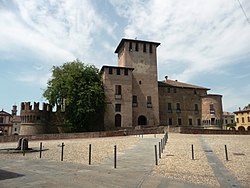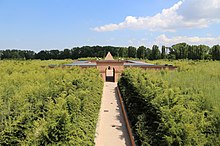Fontanellato
Fontanellato | |
|---|---|
| Comune di Fontanellato | |
 Rocca Sanvitale | |
UTC+2 (CEST) | |
| Postal code | 43012 |
| Dialing code | 0521 |
| Website | Official website |
Fontanellato (
.The town was built up in the 15th century around the moated and fortified house of the Sanvitale family, the
The shrine to the
One of the main attractions of the town is the Labirinto della Masone, once the largest maze in the world, built by native son Franco Maria Ricci totally from Bamboo.[3]
History
The territory corresponding to today's Fontanellato was already inhabited during the Bronze Age, as demonstrated by the studies carried out by Luigi Pigorini at the end of the 19th century. It was later colonized by the Romans. The toponym Fontanellato probably derives from the medieval "Fontana Lata" (large spring), with reference to the natural springs of the plain that can still be observed today in the Lower Parma area; the same water ditch, still present around the Sanvitale fortress, is to be associated with these spring phenomena.
A massive reclamation took place shortly after 1000 by the Cistercian monks of the nearby abbey of Fontevivo. Starting from 1100, Fontanellato found itself at the center of the struggles between the nascent municipalities along the Via Emilia; the first nucleus of the castle dates back to that time: in 1124 the first defensive tower of the village was erected by the Pallavicinos. In 1145, Fontanellato was sold by Oberto Pallavicino to the town of Piacenza; subsequently it changed hands several times, until 1386, the year in which Antonio Sanvitale became feudal lord. In the early years of the 15th century, the management of the territory, the fortress, the infrastructures and the legislative, judicial and executive system of the Fontanellatese territory was entrusted on an operational level to the mayor of Azarino Platoni.
The Sanvitale family maintained a close link with the village for more than five centuries: only in 1948 did Giovanni Sanvitale sell the castle to the municipal administration, which subjected it to complete restoration, transforming it into an important tourist attraction, home to fairs, exhibitions and events.
Tourism and culture
The ancient village preserves various monuments of interest; the
Rocca Sanvitale

Originally built in 1124 as a defensive tower at the behest of the
Sanctuary of the Beata Vergine del Santo Rosario

Built by the
Labirinto della Masone

The Labirinto della Masone (The Mason Labyrinth) is a cultural park built nearby Fontanellato. It extends for seven hectares and includes a labyrinth made up of bamboo of different species (the largest of its kind in the world) and spaces that house the art collection of Franco Maria Ricci and his publishing house, temporary exhibitions, conferences, concerts, a restaurant, a café and a delicatessen.
The art collection, spread over five thousand square meters, was collected by Franco Maria Ricci in about fifty years of activity, it reflects his personal taste and is constantly expanding. The works, including paintings, sculptures and art objects, are about five hundred. It starts from the 16th century, in particular there are works by Mannerist artists, among which Girolamo Mazzola Bedoli, Luca Cambiaso and Ludovico Carracci stand out. The seventeenth century is widely represented both in painting and in sculpture, with works by Valentin de Boulogne, Philippe de Champaigne, Gian Lorenzo Bernini, Giambattista Foggini, Lorenzo Merlini. Ample space is dedicated to the eighteenth and nineteenth centuries, with paintings by Francesco Hayez, Giovanni Carnovali, pastels by Rosalba Carriera and Jean-Étienne Liotard, watercolors by Giuseppe Pietro Bagetti, marble sculptures from the neoclassical period depicting mainly characters linked to Napoleon (and Napoleon himself), by Antonio Canova, Lorenzo Bartolini, François Joseph Bosio and French terracottas. Particular attention is paid to artists originating in the Parma area or who have worked there, making an important artistic contribution, including Pietro Melchiorre Ferrari, Giuseppe Baldrighi and Jean Baptiste Boudard. Another main theme of the collection is that of the Vanitas, in which the works of Jacopo Ligozzi and Maurizio Bottoni stand out. As for the twentieth century, the sculptures by Adolfo Wildt and Demetre Chiparus, the paintings by Antonio Ligabue and Alberto Savinio and the tempera by Erté are noteworthy. Finally, there are also numerous art objects, including a wooden model of the Milan Cathedral and one of the Cathedral of Ulm, two narwhal teeth, and an altar in semiprecious stones and ebony.
World War II POW camp
During
On 6–9 September 2013, to celebrate the 70th anniversary of this event a conference was held in the Rocca on prisoners of war in World War II, with other celebrations and commemorations, jointly by the town and the Monte San Martino Trust. One of the escaping prisoners was the English writer Eric Newby, who memorably detailed his escape and subsequent experiences in the 1971 memoir, Love and War in the Apennines.[6][5][7][8][9]
The building is now a centre for neurological disorders.
Twin cities
Fontanellato is twinned with:
References
- ^ "Superficie di Comuni Province e Regioni italiane al 9 ottobre 2011". Italian National Institute of Statistics. Retrieved 16 March 2019.
- Istat.
- ^ "Franco Maria Ricci — Stories Apartamento Magazine". 11 May 2018.
- ^ Note: Colonel Vicedomini was imprisoned in Germany as a result of this act of humanity and died soon after the war.
- ^ a b Newby, Eric (1971). Love and War in the Apennines.
- ^ English, Ian (1997). Home by Christmas?. Revised and reprinted 2017.
recounts the remarkable adventures experienced by some of the 600 prisoners of war who marched out of camp PG49 at Fontanellato after the Armistice on September 8th 1943
Obit of Ian English - ^ Carver, Tom (June 2010). Where the hell have you been?. Allen & Unwin. Excerpt
- ISBN 9780953896455.
- ^ Clarke, Jack (29 September 2012). "Not too much hardship at Fontanellato". Birmingham Post. Archived from the original on 29 September 2012. Retrieved 23 August 2020.
External links
- Fontanellato tourist office Archived 2002-09-29 at the Wayback Machine (in Italian)
- Comune di Fontanellato (in Italian)
- History of Fontanellato



